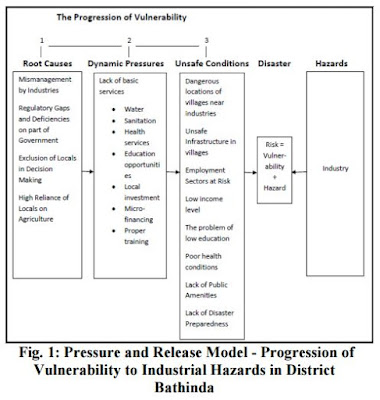This morning I received an email from UNISDR on the official publication of the Sendai Framework for Disaster Risk Reduction. You can access it here.
So, today I am thinking again about the root causes of vulnerability, and whether the new Sendai Framework helps address these root causes.
One of the early models that most DRR professionals are familiar with, is the "Pressure and Release" (PAR) model, developed by Blaikie et al in 1994 and published in the seminal book "At Risk" by Ian Davis, Ben Wisner, Terry Cannon and Piers Blaikie. Here is the PAR model in a basic form:
And here is a nice, basic diagram of how this model was applied to analyze the progression of vulnerability to industrial hazards in Bathinda district in Punjab:
(Image courtesy http://www.irjcjournals.org/ijmssr/May2014/5.pdf, accessed 1 July, 2015)
Finally, I particularly like the example from the "At Risk" book on the Sudan famine, as it demonstrates one of the salient features of PAR model which is facilitating a deeper look into the political economy in order to trace root causes of vulnerability:
What do you think? Does the Sendai Framework advance our thinking and ability to address root causes of vulnerability? Will a result of this be tangible resilience for people at risk, communities and nations?
Wednesday, July 1, 2015
Subscribe to:
Comments (Atom)








